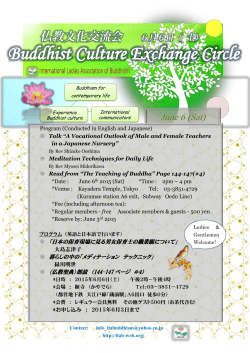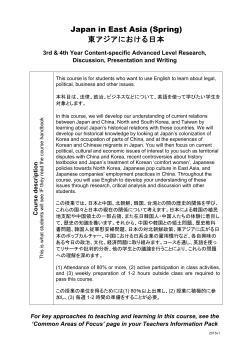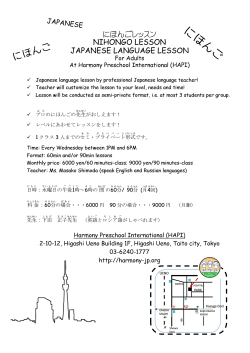
PDF - Minneapolis Institute of Arts
For Immediate Release Contact: Elyse Topalian Naomi Takafuchi Masterpieces of Japanese and Korean Art from Renowned Mary Griggs Burke Collection Donated to Metropolitan Museum of Art and Minneapolis Institute of Arts through Landmark Bequests (New York, March 16, 2015)—The Metropolitan Museum of Art and Minneapolis Institute of Arts (MIA) announced jointly today that they are both recipients of transformative bequests of masterworks of Japanese art from the Mary Griggs Burke Collection. With objects spanning more than five millennia, the collection is widely regarded as the finest and most encompassing private collection of Japanese art outside Japan. Mrs. Burke (1916–2012), who assembled her formidable collection of East Asian art over five decades, announced in 2006 that she would bequeath her Japanese and a smaller collection of Korean works to the two institutions. Overall, the Mary Griggs Burke Collection comprises approximately 1,000 works in various media—more than 850 Japanese works, some 90 Korean pieces, and about 65 Chinese works of art. The core of the collection is Japanese painting, consisting of 450 works in screen, hanging scroll, handscroll, and album formats, and around 40 works of Japanese calligraphy, as well as a small number of ukiyo-e prints and woodblock printed illustrated books. Mrs. Burke’s discerning collecting interests also extended to Buddhist and Shinto statuary, ceramics, and lacquerware. Art through a Lifetime: The Mary Griggs Burke Collection, the two-volume catalogue raisonné of the collection edited by Miyeko Murase, was published in 2013. The Met and the Minneapolis Institute of Arts were informed of the final terms of the gift agreements by the Mary and Jackson Burke Foundation in late February. Mrs. Burke had made the provisions for the division of the collection in 2007; the gift agreements respect her wishes and also include several works subsequently acquired by the Foundation. In addition, each institution will receive a generous cash endowment of $12.5 million, to be used primarily for the purchase of Japanese art and also for the funding of exhibitions, programming, and fellowships. The Foundation further announced that the Chinese paintings and objects from the collection would be presented to the Yale University Art (more) Mary Griggs Burke Collection Donated to The Met and MIA Page 2 Gallery, and that select contemporary works would be given to the Morikami Museum and Japanese Gardens in Delray Beach, Florida. Both the Metropolitan Museum and the Minneapolis Institute of Arts will present major exhibitions of their gifts from the Burke Collection this fall. Thomas P. Campbell, Director and CEO of the Metropolitan Museum, commented: “The vision and generosity of Mary Griggs Burke shine throughout this landmark gift of over 300 masterworks of Japanese and Korean art to the Met. She was a consummate collector, trustee, and friend, who selected these superb works with great care to complement and augment our existing holdings. It is inconceivable that a collection comparable to hers could be assembled today. Given their rarity, aesthetic quality, and art historical importance, her gifts raise the level of the Met’s Japanese collection to one of the finest and most comprehensive outside Japan.” The announcement of the works in the bequest coincides with the launch of the Museum’s centennial celebration marking the founding of its Asian Art Department. “We are thrilled to receive this transformative bequest from Mary Griggs Burke,” said Kaywin Feldman, Duncan and Nivin MacMillan Director and President of the Minneapolis Institute of Arts. “The Minneapolis Institute of Arts is one of the nation’s principal repositories of Japanese art. This bequest of nearly 700 objects, from prehistoric to contemporary times, adds exciting depth to our encyclopedic collections. The gift will join the museum's existing Japanese art collection, and we look forward to further enhancing the depth of our installations of Japanese art and culture in our 15 galleries dedicated to Japanese art. This gift is also a testament to the scholarship, research, and focused collecting of Dr. Matthew Welch. Under Matthew's leadership, the significance of the MIA's collection of Japanese and Korean art at the MIA has greatly expanded.” Matthew Welch, Deputy Director & Chief Curator at the MIA, who knew Mrs. Burke well and visited with her innumerable times for over 20 years, added, “Mrs. Burke was an astute collector, blessed with her own discriminating eye, but also wisely advised in amassing her remarkable collection. The importance of this gift to the MIA cannot be overstated. With this gift, as well as a recently established endowment for Asian art programming and the addition of key staff positions in Japanese art at the MIA, we are poised to become a leading center for the study of Japanese art.” When finalizing the lists of gifts to the Metropolitan Museum and the Minneapolis Institute of Arts, Mrs. Burke considered the strengths and weaknesses of each institution’s holdings of Japanese and Korean art. For example, if the Met already had a work of a certain genre or by a particular Japanese artist, that was comparable to one of her own, she opted to give her work to Minneapolis. Similarly, for Korean art, she designated more than 70 ceramic works to be donated to Minneapolis, with none going to the Met, where strong holdings of Korean ceramics already exist; the Met, however, received an exceedingly rare late (more) Mary Griggs Burke Collection Donated to The Met and MIA Page 3 medieval Buddhist painting of Shakyamuni and a gilt wood statue of a bodhisattva that augment its holdings in this area. Highlights Presented to the Met The Met’s collection of early medieval Buddhist art will be greatly enhanced by powerful sculptures of the Buddhist protective deity Fudō Myōō and the bodhisattva Jizō by the master sculptor Kaikei (active 1185–1223). Ink paintings of the Muromachi period (1391– 1573)—an area of particular strength within the Burke Collection—is represented by Sesson Shūkei’s (1504–89?) deftly brushed Seven Sages of the Bamboo Grove. The Burke Collection is also noted for works in every medium illustrating scenes from traditional Japanese narratives. The sumptuous 17th-century set of screens Willows and Bridgeis thought to represent the bridge over the Uji River, in southeast Kyoto, a site celebrated in Japanese literature. A painting of a courtier traveling through a mountain pass based on an episode from the Tales of Ise, a 10th-century court classic, is by the celebrated 17th-century Kyoto painter Tawaraya Sōtatsu. Moving to the Edo period (1615–1868), works by great individualist masters of the 18thcentury are represented in the collection by superlative works such as White Plum Blossoms and Moon by Itō Jakuchū (1716–1800) and Lions at the Stone Bridge of Tendaisan by Soga Shōhaku (1730–81). Literati art, inspired by Sinophilic ideals, is encapsulated byGathering at the Orchid Pavilion, a masterpiece of screen painting by Ike Taiga (1723–76) that depicts a legendary poetry party held in ancient China. Coinciding with the official acceptance of the remarkable benefaction from the Burke Foundation, on March 10, the Met’s Board of Trustees named John T. Carpenter the Mary Griggs Burke Curator of Japanese art. The Met will also commemorate the gift of the collection by hosting an annual Mary Griggs Burke Lecture. Dr. Carpenter stated, “As a graduate student at Columbia University in the late ’80s and early ’90s, I fondly recall how Mrs. Burke so graciously welcomed scholars from near and far to her New York apartment to study works directly. Now, 20 years later, as a curator at the Met, I look forward to welcoming students from major research universities nearby and watching as our millions of visitors from around the world come to visit the Arts of Japan galleries and the newly acquired masterworks of Japanese art from the Burke Collection.” Highlights Presented to the Minneapolis Institute of Arts Among the objects the MIA will receive are stunning ink paintings from Japan’s Muromachi period (1392–1573) showing the bodhisattva Monju by the artist Kichizan Mincho (1352– 1431). Other highlights include a 16th-century water jar (mizusashi) known as “Burst Bag” from the kilns in Iga for use in tea ceremony; a pair of folding screens of hollyhocks and plum trees by the artist Ogata Kenzan (1663–1743); a pair of screens of Chinese children playing “crack the whip” and examining an elephant by the eccentric artist Nagasawa Rosetsu (1754–1799); and a luminous 12th-century celadon Korean maebyong vessel (more) Mary Griggs Burke Collection Donated to The Met and MIA Page 4 inlaid with a pattern of crane amid clouds. In recognition of Burke’s incredible generosity, Dr. Andreas Marks will be named the Mary Griggs Burke Curator of Japanese and Korean Art. The gift will join the museum's existing Japanese art collection that will rise to 7,700 objects, making it one of the most significant encyclopedic collections of Japanese art in the nation. Like the Metropolitan, the MIA will host an annual Mary Griggs Burke Lecture. Upcoming Exhibitions of Donated Works Works of art from the two bequests will be on view in two major exhibitions scheduled to take place in fall 2015: Gifts of Japanese and Korean Art from the Mary Griggs Burke Collection will go on view at the Minneapolis Institute of Arts from September 26, 2015 through April 2016. The Japanese art collection of St. Paul native Mary Griggs Burke has long been considered the finest private collection of its kind outside of Japan. The museum will highlight the breadth of this gift by featuring more than 170 masterpieces of Japanese and Korean art, ranging from prehistoric to the late 19th century. Celebrating the Arts of Japan: The Mary Griggs Burke Collection will be on view at The Metropolitan Museum of Art in New York from October 20, 2015, through July 31, 2016. Organized by Dr. Carpenter and Dr. Monika Bincsik, assistant curator in the Department of Asian Art, the exhibition will showcase more than 150 masterpieces—including paintings, sculpture, ceramics, calligraphy, lacquerware, and ukiyo-e prints—that reveal the remarkable range and quality of Mrs. Burke’s activities as a collector over the course of nearly 50 years. About Mary Griggs Burke Mrs. Burke—who was born in 1916 in Saint Paul, Minnesota, and raised there—maintained a lifelong association with the city and its cultural institutions. Her maternal grandfather, Crawford Livingston, and paternal grandfather, Colonel Chauncey Griggs, were two St. Paul civic leaders who made fortunes in lumber, railroads, and utilities. The young Mary Griggs grew up in a Victorian mansion in St. Paul that was awash in 18th-century French objets d’art but that was also home to a few Japanese pieces her mother had acquired. Mrs. Burke’s mother, Mary Livingston Griggs, visited Japan on a world tour in 1902. The trip inspired Mrs. Burke, who visited Japan for the first time in 1954 and made more than 30 subsequent trips. She attended Sarah Lawrence College, where she studied painting with Bradley Walker Tomlin, and later took graduate courses in art history at Columbia University and at the Institute of Fine Arts in New York City. She made her first trip to Japan in 1954, at the suggestion of the architect Walter Gropius, to study landscape design for the house she was building in Oyster Bay, Long Island. She was profoundly moved by the art that she saw (more) Mary Griggs Burke Collection Donated to The Met and MIA Page 5 there and by their understanding of art as an all-embracing way of life. Along with Jackson Burke, a printer and type designer whom she married in 1955, she began to build an art collection in the early 1960s, when they were among relatively few Americans who were seriously interested in Japanese art. Beginning with the acquisition of ukiyo-e paintings, they soon turned their attention to other areas of Japanese art, and the collection expanded to include all major schools of painting, as well as calligraphy, sculpture, lacquerware, textiles, and ceramics. After her husband’s death in 1975, Mrs. Burke continued to work for various charities and to build her Asian art collection for another three decades. She was also very active as a donor and advisor to the Metropolitan Museum for more than three decades, serving as a Trustee beginning in 1976 and as Trustee Emerita from 1995 on, and on committees for acquisitions, education, and other areas. She donated works of art and acquisition funds to the Department of Asian Art, lent works frequently to be shown in the Arts of Japan galleries, and funded research on Japanese art in the Met’s collection. Mrs. Burke lived most of her adult life in New York City near the Metropolitan Museum, in a suite of apartments, some of which were converted into galleries for the display of East Asian art. She also maintained homes in Oyster Bay, Long Island, Hobe Sound, Florida, and Wisconsin. She died in 2012 at the age of 96, at her home in Manhattan. Earlier Exhibitions, Awards, and Advisors The first exhibition of the Burke Collection took place at the Metropolitan Museum in 1975, when the collection was still in its early stages, organized by Julia Meech. Ten years later, an exhibition of treasures from her collection at the Tokyo National Museum became the first exhibition of a Western collection of Japanese art to be shown in Japan. In 1987, the Japanese government awarded Mrs. Burke The Order of the Sacred Treasure, Gold and Silver Star, in recognition of her support of cultural exchange between the United States and Japan. In subsequent years, works from the Burke Collection have been featured in numerous exhibitions in Japan and the West. Another major exhibition, Bridge of Dreams: Japanese Art from the Mary Griggs Burke Collection, was presented at the Metropolitan Museum in 2000, representing the culmination of nearly 40 years of Mrs. Burke’s collecting. In building such a distinguished collection, Mrs. Burke was guided by her own collecting instincts. She also relied on the advice of experts, especially Miyeko Murase, professor emerita at Columbia University and former Special Consultant for Japanese Art at The Metropolitan Museum of Art. Their collaboration extended over 50 years. Dr. Murase supervised the two major Burke Collection exhibitions at the Met and their accompanying publications, in 1975 and 2000. She also edited Art through a Lifetime, a two-volume (more) Mary Griggs Burke Collection Donated to The Met and MIA Page 6 catalogue raisonné of the collection. As the Burke Collection grew in size and importance, it required its own curatorial staff. Its dedicated curators were Andrew Pekarik, from 1973 to 1984, and, later, Gratia Williams Nakahashi and Stephanie Wada. ### March 16, 2015 For media inquiries, please contact: At The Metropolitan Museum of Art: Elyse Topalian or Naomi Takafuchi 212-570-3951 communications@metmuseum.org At the Minneapolis Institute of Arts: Anne-Marie Wagener or Tammy Pleshek 612-870-3280; 612-870-3171 awagener@artsmia.org; tpleshek@artsmia.org
© Copyright 2025









